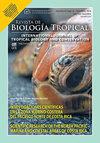在中墨西哥太平洋积极进行恢复工作,作为珊瑚礁恢复的一项战略
IF 0.6
4区 生物学
Q4 BIOLOGY
引用次数: 0
摘要
简介:1997-98年的厄尔尼诺事件在墨西哥中太平洋造成了大规模的珊瑚白化和死亡。仅Punta de Mita一地过去就拥有该地区30%以上的珊瑚覆盖率,具有单一的Pocillopora覆盖率。1997-1998年ENSO事件造成大量珊瑚死亡,使活珊瑚覆盖率降至<5%。尽管被认为是一个不太可能恢复的珊瑚区,但最近已经开展了恢复工作,以恢复珊瑚群落。目的:通过分析Punta de Mita分支Pocillopora物种的珊瑚生长和存活率,评估珊瑚的恢复情况。方法:使用拉链将健康的机会珊瑚碎片重新连接到天然基质上,并根据其最大长度和宽度(cm)进行测量,以确定其年度扩展率。结果:50周后,珊瑚的大小成倍增加,平均每年增长约4厘米。100周(2年)后,珊瑚的大小增加了两倍,每个直径平均增加8-9厘米。结论:墨西哥中部太平洋成功的珊瑚礁恢复活动是Pocillopora的生理过程的结果,如快速生长率和最近的生活史特征,如应对热异常的能力,这使它们能够在受自然和人为扰动严重影响的动态区域中茁壮成长。事实上,一个被认为不太可能恢复的地区已经恢复了其活珊瑚覆盖率,从1998年的<5%上升到20年后的15%。这表明了通过恢复工作协助自然珊瑚恢复的重要性,特别是在珊瑚位置,尽管环境受到干扰,但这些珊瑚位置已被证明是有弹性的,在当前气候变化的情况下可能成为珊瑚避难所。本文章由计算机程序翻译,如有差异,请以英文原文为准。
Active restoration efforts in the Central Mexican Pacific as a strategy for coral reef recovery
Introduction: The 1997-98 El Niño event caused massive coral bleaching and mortality in the Central Mexican Pacific (CMP). Punta de Mita alone used to harbor more than 30 % of the coral coverage in this region, with a mono-specific Pocillopora coverage. The 1997-1998 ENSO event caused massive coral mortality reducing live coral coverage to < 5 %. Despite being considered a coral region unlikely to recover, recent restoration efforts have been implemented to rehabilitate the coral community.
Objective: To assess coral recovery by analyzing the coral growth and survival rates of branching Pocillopora species at Punta de Mita.
Methods: Healthy coral fragments of opportunity were re-attached to the natural substrata using zip ties and measured considering their growth in terms of maximum length and width (cm) to determine their annual extension rates.
Results: After 50 weeks, corals duplicated their size, with a mean growth of ~ 4 cm year-1. After 100 weeks (2 years), corals triplicated their size, increasing on average 8–9 cm in each diameter.
Conclusions: Successful coral reef restoration activities in the Central Mexican Pacific are the result of Pocillopora’s physiological processes, such as fast growth rates, and recent life-history traits, like the ability to cope with thermal anomalies, which enable them to thrive in a dynamic region severely affected by natural and anthropogenic perturbations. Indeed, a region considered unlikely to recover has regained its live coral cover from < 5 % in 1998 up to 15 % in 20 years. This demonstrates the importance of assisting natural coral recovery with restoration efforts, especially in coral locations that, despite environmental perturbations, have proven to be resilient and may become coral refugia areas under the current climate change scenario.
求助全文
通过发布文献求助,成功后即可免费获取论文全文。
去求助
来源期刊

Revista De Biologia Tropical
生物-生物学
CiteScore
1.80
自引率
0.00%
发文量
23
审稿时长
4-8 weeks
期刊介绍:
The Revista de Biología Tropical / International Journal of Tropical Biology and Conservation is a mainstream scientific journal published since 1953 and covered by Web of Science; Science Citation Index; Current Contents; Google Scholar; Scopus, SciELO and nearly 50 additional indices.
A double blind system guarantees you a fair evaluation, and our world class editorial and scientific boards provides a first decision in three working days. The journal is Full Open Access and is widely read where your article can have the highest real impact.
Since its beginning in 1953, the Revista follows these principles: objective and independent evaluation of all manuscripts; transparency in all processes; ethical use of procedures, data, specimens and subjects; fair treatment of all parties; and absolute predominance of scientific rigor over any other aspect.
 求助内容:
求助内容: 应助结果提醒方式:
应助结果提醒方式:


